 Nearsightedness happens when the physical eye length is bigger than the optical length. This often develops in the fast growing school-aged children or teenager and progresses during growth years. This requires frequents changes in contact lenses or glasses. This affects both male and female equally. People with nearsightedness family history are likely to develop this eye defect. Many nearsighted eyes are entirely healthy but a small portion of people with this condition develop a kind of retinal degeneration.
Nearsightedness happens when the physical eye length is bigger than the optical length. This often develops in the fast growing school-aged children or teenager and progresses during growth years. This requires frequents changes in contact lenses or glasses. This affects both male and female equally. People with nearsightedness family history are likely to develop this eye defect. Many nearsighted eyes are entirely healthy but a small portion of people with this condition develop a kind of retinal degeneration.
Some nearsighted symptoms may include headaches, eyestrain, difficulty in seeing far objects, squinting to see properly and having difficulty seeing road signs and blackboard in school. The symptoms could be apparent in children between the ages eight and twelve. In the teenage years, when the body rapidly grows, this condition may become worse. A person who is nearsighted could easily read the Jaeger eye chart which is for near reading but finds the Snellen eye chart, which is for distance reading hard to read.
Some other nearsighted symptoms include blurriness, blood in the eye, dark spots in the vision, double vision, eye discharge, crusty eyelashes or eyelid, light flashes, dryness, grittiness, itchiness, floaters in vision, eye pain and vision loss. A person with this illness clearly sees objects that are near but distant objects appear blurred.